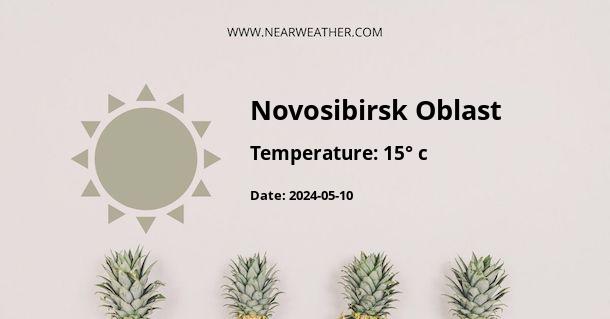Weather
-9° 
Climate Conditions: overcast clouds
Humidity: 87%
Wind speed: 19.66 km/h
Wind direction: 181°
Daily Weather Forecast
Thursday
12/19/2024
Climate Conditions: overcast clouds
Humidity: 88%
Friday
12/20/2024
Climate Conditions: overcast clouds
Humidity: 76%
Saturday
12/21/2024
Climate Conditions: light snow
Humidity: 95%
Sunday
12/22/2024
Climate Conditions: broken clouds
Humidity: 98%
Monday
12/23/2024
Climate Conditions: overcast clouds
Humidity: 98%
Tuesday
12/24/2024
Climate Conditions: overcast clouds
Humidity: 100%
Evolution
Daily Weather Forecast Evolution (°C)
Lowest temperature
Highest temperature
Other Information
Sunrise
10:02
Sunset
17:12
Latitude
55.000000
Longitude
80.000000
Timezone: GMT+05:30
More about Novosibirsk Oblast:
Climate and Weather in Novosibirskaya Oblast’, Russia
Novosibirskaya Oblast’, located in southwestern Siberia, Russia, experiences a continental climate characterized by long, cold winters and short, warm summers. The region is known for its extreme temperature variations, with bitterly cold winters and relatively hot summers. This article will provide an in-depth overview of the climate and weather conditions in Novosibirskaya Oblast’ throughout the year.Seasonal Temperature Variation
Novosibirskaya Oblast’ experiences a significant variation in temperature between the seasons. The winters are long and frigid, with temperatures often dropping well below freezing. In January, the coldest month, average temperatures range from -18°C to -12°C (-0.4°F to 10.4°F). It is not uncommon for temperatures to plummet even further, reaching as low as -40°C (-40°F) during severe cold snaps. Summer, on the other hand, brings relatively warm temperatures to the region. July, the hottest month, sees average temperatures ranging from 19°C to 23°C (66.2°F to 73.4°F). However, it is important to note that temperatures can occasionally soar above 30°C (86°F) during heatwaves.Precipitation
Novosibirskaya Oblast’ has a relatively low annual precipitation compared to other regions in Russia. The region receives an average of around 400-500 millimeters (15.7-19.7 inches) of precipitation per year, with the majority falling during the summer months. During the winter, precipitation primarily comes in the form of snow. The region experiences snowfall from October to April, with the heaviest snowfall occurring in December and January. Snow cover can reach significant depths, with an average snow depth of around 20-30 centimeters (7.9-11.8 inches) in winter. In the summer months, rainfall becomes more frequent, often in the form of showers or thunderstorms. July and August are the wettest months, receiving around 60-80 millimeters (2.4-3.1 inches) of rainfall on average.Sunshine Hours
Novosibirskaya Oblast’ enjoys a moderate number of sunshine hours throughout the year. During the long summer days, the region experiences extended daylight hours, with the sun rising early and setting late. In June, the longest day of the year, Novosibirskaya Oblast’ receives approximately 17 hours of daylight. In contrast, the winter months have significantly fewer daylight hours. December, the shortest day of the year, sees only about 6 hours of daylight. This variation in daylight hours contributes to the extreme temperature differences between the seasons.Wind Patterns
The wind patterns in Novosibirskaya Oblast’ are influenced by the region's geographical location and topography. The region is characterized by a moderately strong prevailing westerly wind, which brings cold air masses from the Arctic and Siberian plains during the winter months. During the summer, the wind patterns shift, and warm air masses from the south contribute to the relatively higher temperatures. The prevailing wind direction becomes more variable, influenced by local weather systems and the surrounding topography.Extreme Weather Events
Novosibirskaya Oblast’ occasionally experiences extreme weather events that can have a significant impact on the region. Severe cold waves during winter can lead to dangerous conditions, such as frostbite and hypothermia. Additionally, heavy snowfall and blizzards can cause transportation disruptions and power outages. In the summer, heatwaves can bring scorching temperatures, increasing the risk of heat-related illnesses. Thunderstorms with strong winds and heavy rainfall can also occur, potentially causing localized flooding.Conclusion
Novosibirskaya Oblast’ in Russia experiences a continental climate with long, cold winters and short, warm summers. The region's extreme temperature variations, from frigid winter lows to relatively hot summer highs, make Novosibirskaya Oblast’ a challenging environment to live in. It is crucial for residents and visitors to be prepared for the harsh winters and to take precautions during heatwaves and extreme weather events.FAQ's about Novosibirsk Oblast's Weather:
Q - What is the Latitude and Longitude of Novosibirsk Oblast?
A - Novosibirsk Oblast's Latitude is 55.000000 & Longitude is 80.000000.
Q - What is the weather in Novosibirsk Oblast today?
A - Weather in Novosibirsk Oblast is -9° today.
Q - What is the climatic condition of Novosibirsk Oblast today?
A - Climate Conditions in Novosibirsk Oblast shows overcast clouds today.
Q - What is the humidity in Novosibirsk Oblast today?
A - Humidity in Novosibirsk Oblast is 87% today.
Q - What is the wind speed in Novosibirsk Oblast today?
A - Wind speed in Novosibirsk Oblast is 19.66 km/h, flowing at 181° wind direction. today.

Nearby Locations
Latest searched locations